Henry David Thoreau (July 12, 1817 – May 6, 1862) was an American essayist, poet, and philosopher.
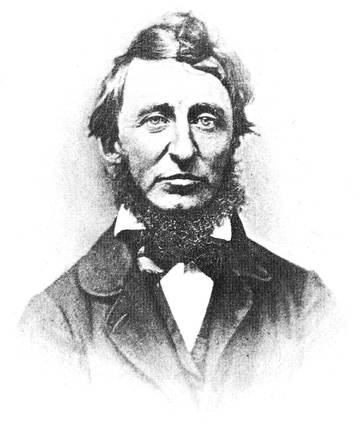
Thoreau in 1856
Born David Henry Thoreau
July 12, 1817
Concord, Massachusetts, U.S.
Died May 6, 1862 (aged 44)
Concord, Massachusetts, U.S.
Alma mater Harvard College
Era 19th century philosophy
Region Western philosophy
School Transcendentalism
Main interests:
Ethics
Poetry
Religion
Politics
Biology
Philosophy
History
Signature: 
Thoreau's books, articles, essays, journals, and poetry amount to more than 20 volumes.
His literary style interweaves close observation of nature, personal experience, pointed rhetoric, symbolic meanings, and historical lore, while displaying a poetic sensibility, philosophical austerity, and attention to practical detail.
Physical appearance
Thoreau had a distinctive appearance, with a nose that he called his "most prominent feature".
Of his appearance and disposition, Ellery Channing wrote:
His face, once seen, could not be forgotten. The features were quite marked: the nose aquiline or very Roman, like one of the portraits of Caesar (more like a beak, as was said); large overhanging brows above the deepest set blue eyes that could be seen, in certain lights, and in others gray,—eyes expressive of all shades of feeling, but never weak or near-sighted; the forehead not unusually broad or high, full of concentrated energy and purpose; the mouth with prominent lips, pursed up with meaning and thought when silent, and giving out when open with the most varied and unusual instructive sayings.
Henry David Thoreau was born David Henry Thoreau in Concord, Massachusetts, into the "modest New England family" of John Thoreau, a pencil maker, and Cynthia Dunbar. His paternal grandfather had been born on the UK crown dependency island of Jersey. His maternal grandfather, Asa Dunbar, led Harvard's 1766 student "Butter Rebellion", the first recorded student protest in the American colonies.David Henry was named after his recently deceased paternal uncle, David Thoreau.
Thoreau's birthplace still exists on Virginia Road in Concord. The house has been restored, and is now open to the public.
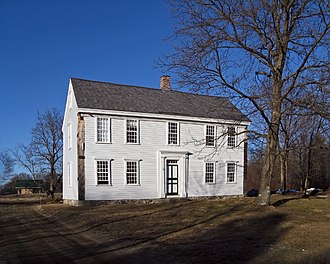
He studied at Harvard College between 1833 and 1837. He lived in Hollis Hall and took courses in rhetoric, classics, philosophy, mathematics, and science.[citation needed] He was a member of the Institute of 1770 (now the Hasty Pudding Club).
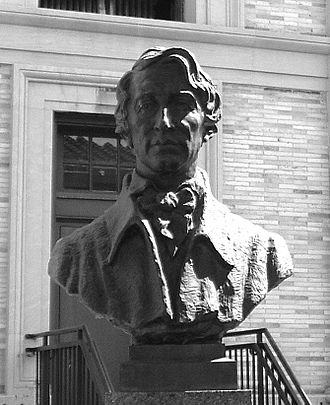
A bust of Thoreau from the Hall of Fame
for Great Americans at the Bronx Community College
The traditional professions open to college graduates—law, the church, business, medicine—did not interest Thoreau.
Upon graduation Thoreau returned home to Concord, where he met Ralph Waldo Emerson through a mutual friend.
Emerson urged Thoreau to contribute essays and poems to a quarterly periodical,
Thoreau was a philosopher of nature and its relation to the human condition.
On April 18, 1841, Thoreau moved into the Emerson house. There, from 1841 to 1844, he served as the children's tutor; he was also an editorial assistant, repairman and gardener.
Thoreau returned to Concord and worked in his family's pencil factory, which he would continue to do alongside his writing and other work for most of his adult life.
Once back in Concord, Thoreau went through a restless period. In April 1844 he and his friend Edward Hoar accidentally set a fire that consumed 300 acres (1.2 km2) of Walden Woods.
I went to the woods because I wished to live deliberately, to front only the essential facts of life, and see if I could not learn what it had to teach, and not, when I came to die, discover that I had not lived. I did not wish to live what was not life, living is so dear; nor did I wish to practise resignation, unless it was quite necessary. I wanted to live deep and suck out all the marrow of life, to live so sturdily and Spartan-like as to put to rout all that was not life, to cut a broad swath and shave close, to drive life into a corner, and reduce it to its lowest terms, and, if it proved to be mean, why then to get the whole and genuine meanness of it, and publish its meanness to the world; or if it were sublime, to know it by experience, and be able to give a true account of it in my next excursion.
— Henry David Thoreau, "Where I Lived, and What I Lived For", in Walden
Thoreau embarked on a two-year experiment in simple living on July 4, 1845, when he moved to a small house he had built on land owned by Emerson in a second-growth forest around the shores of Walden Pond.
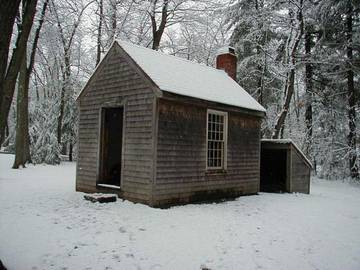
cabin at Walden Pond
Replica of Henry David Thoreau's cabin at Walden Pond State Reservation in Concord, Massachusetts.
The house was in "a pretty pasture and woodlot" of 14 acres (57,000 m2)
that Emerson had bought, 1.5 miles (2.4 km) from his family home.
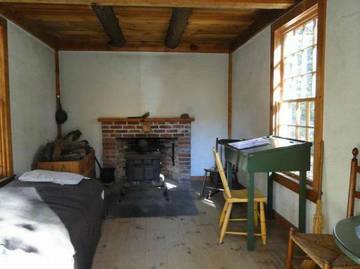
Early in the spring of 1845, Thoreau, then 27 years old, began to chop down tall pines with which to build the foundations of his home on the shores of Walden Pond. From the outset the move gave him profound satisfaction. Once settled, he restricted his diet for the most part to the fruits and vegetables he found growing wild and the beans he planted. When not busy weeding his bean rows and trying to protect them from hungry groundhogs or occupied with fishing, swimming, or rowing, he spent long hours observing and recording the local flora and fauna, reading, and writing A Week on the Concord and Merrimack Rivers (1849).
He also made entries in his journals, which he later polished and included in Walden. Much time, too, was spent in meditation.
He became a land surveyor and continued to write increasingly detailed observations on the natural history of the town, covering an area of 26 square miles (67 km2), in his journal, a two-million-word document he kept for 24 years. He also kept a series of notebooks, and these observations became the source of his late writings on natural history, such as "Autumnal Tints", "The Succession of Trees", and "Wild Apples", an essay lamenting the destruction of indigenous wild apple species.
Out of such activity and thought came Walden, a series of 18 essays describing Thoreau’s experiment in basic living and his effort to set his time free for leisure. Several of the essays provide his original perspective on the meaning of work and leisure and describe his experiment in living as simply and self-sufficiently as possible, while in others Thoreau described the various realities of life at Walden Pond: his intimacy with the small animals he came in contact with; the sounds, smells, and look of woods and water at various seasons; the music of wind in telegraph wires—in short, the felicities of learning how to fulfill his desire to live as simply and self-sufficiently as possible. The physical act of living day by day at Walden Pond is what gives the book authority, while Thoreau’s command of a clear, straightforward, elegant style helped raise it to the level of a literary classic.
Thoreau stayed for two years at Walden Pond (1845–47). In the summer of 1847 Emerson invited him to stay with his wife and children again, while Emerson himself went to Europe. Thoreau accepted, and in September 1847 he left his cabin forever.


 Learn English for free
Learn English for free 









